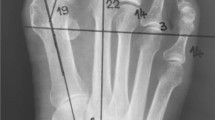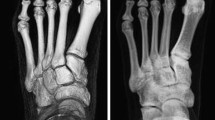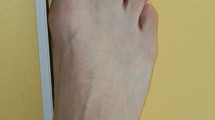Abstract
The aim of this study was to confirm whether the length of the first metatarsal and the length of the hallux are greater than normal in the initial phase of the hallux valgus deformity. In a sample of 152 radiographs (98 of normal feet and 54 of incipient hallux valgus feet), the length of the first metatarsal and the hallux was measured according to methods previously described. Comparisons were made between normal and hallux valgus feet, and between male and female feet. The results show significant differences between the two groups in the first metatarsal (P < 0.0001) and hallux (P < 0.001). In the male feet, these differences are more marked (when comparing the length of the hallux between the female hallux valgus feet and the female normal feet, P > 0.05). This indicates that in men with hallux valgus, the excess in length of the first metatarso-digital segment is greater than in women that develop this deformity, at least in its initial phase. According to these results, the size of the first metatarso-digital segment could be involved in the development of the hallux valgus deformity.
Résumé
Le but de cette étude est de confirmer l’excès de longueur du premier métatarsiens et du gros orteil lors de la survenue d’une déformation en hallux valgus. Cent cinquante-deux radiographies ont été analysées, 98 pieds normaux, 54 pieds présentant un début d’hallux valgus. La longueur du premier métatarsien et de l’hallux ont été mesurées et la comparaison a été réalisée entre les deux variétés de pieds, et entre les hommes et les femmes. Les résultats de cette étude montrent qu’il existe une différence significative entre les deux groupes P < 0.0001 pour le premier métatarsien et p < 0.001 pour la longueur du gros orteil. Cette différence est beaucoup plus marquée chez l’homme que chez la femme. Cette étude montre donc que chez l’homme présentant un hallux valgus, l’excès de longueur du premier métatarsien et du gros orteil sont plus importants que chez la femme, au moins au début de la déformation. Ceci doit être pris en compte lors de la survenue d’un Hallux Valgus.





Similar content being viewed by others
References
Bojsen-Möller F, Lamoreux L (1979) Significance of free dorsiflexion of the toes in walking. Acta Orthop Scand 50:471–479
Bonney G, Macnab I (1952) Hallux valgus and hallux rigidus. A critical survey of operative results. J Bone Joint Surg 34B:366–385
Coughlin MJ (1995) Juvenile hallux valgus: etiology and treatment. Foot Ankle Int 16:682–697
Coughlin MJ, Saltzman CL, Nunley JA (2002) Angular measurements in the evaluation of hallux valgus deformities: a report on the Ad Hoc committee of the American Orthopaedic Foot And Ankle Society on Angular Measurements. Foot Ankle Int 23:68–74
Coughlin MJ, Shurnas PS (2003) Hallux rigidus: demographics, etiology, and radiographic assessment. Foot Ankle Int 24:731–743
Davitt JS, Kadel N, Sangeorzan BJ, Hansen ST Jr, Holt SK, Donaldson-Fletcher E (2005) An association between functional second metatarsal length and midfoot arthrosis. J Bone Joint Surg 87A:795–800
Ferrari J, Hopkinson DA, Linney AD (2004) Size and shape differences between male and female foot bones. Is the female foot predisposed to hallux abducto valgus? J Am Podiatr Med Assoc 94:434–452
Giannestras NJ (1979) Hallux valgus y hallux rigidus. In: Giannestras NJ (ed) Trastornos del Pie. Salvat Editores, Barcelona, pp 345–401
Hardy RH, Clapham JC (1951) Observations on hallux valgus. J Bone Joint Surg 33B:376–391
Heden RI, Sorto LA (1981) The buckle point and the metatarsal protrusion´s relationship to hallux valgus. J Am Podiatr Assoc 71:200–208
Kelikian H (1965) Hallux valgus, allied deformities of the forefoot and metatarsalgia. WB Saunders, Philadelphia
Lamur KS, Huson A, Snijders CJ, Stoeckart R (1996) Geometric data of hallux valgus feet. Foot Ankle Int 17:548–554
LaPorta DM, Melillo TV, Hetherington VJ (1994) Preoperative assessment in hallux valgus. In: Hetherington VJ (ed) Hallux valgus and forefoot surgery. Churchill Livingstone, New York, pp 07–123
Lundberg BJ, Sulja T (1972) Skeletal parameters in the hallux valgus foot. Acta Orthop Scand 43:576–582
Mann RA, Coughlin MJ (1981) Hallux valgus: etiology, anatomy, treatment and surgical considerations. Clin Orthop 157:31–41
Piggott H (1960) The natural history of hallux valgus in adolescence and early adult life. J Bone Joint Surg 42B:749–760
Piqué C, Maled I, Arabi J, Vila J (2006) Radiographic angles in hallux valgus: differences between measurements made manually and with a computerized program. Foot Ankle Int 27:175–180
Roukis TS, Weil LS Jr, Weil LS Sr, Landsman AS (2005) Predicting articular erosion in hallux valgus: clinical, radiographic, and intraoperative analysis. J Foot Ankle Surg 44:13–21
Smith RW, Chairman P, Reynolds C, Stewart MJ (1984) Hallux valgus assessment: report of Research Committee of American Orthopaedic Foot and Ankle Society. Foot Ankle 5:92–103
Soames RW (1998) Sistema esquelético. In: Williams PL, Bannister LH, Berry MM, Collins P, Dyson M, Dussek JE, Ferguson MWJ (eds) Anatomía de Gray, tomo I, 38th edn. Ediciones Harcourt, Madrid, pp 425–736
Steel MW, Johnson KA, Dewitz MA, Ilstrup DM (1980) Radiographic measurements of the normal adult foot. Foot Ankle 1:151–158
Tanaka Y, Takakura Y, Kumai T, Samoto N, Tamai S (1995) Radiographic analysis of hallux valgus. A two-dimensional coordinate system. J Bone Joint Surg 77A:205–213
Viladot A (1973) Metatarsalgia due to biomechanical alterations of the forefoot. Orthop Clin North Am 4:65–78
Author information
Authors and Affiliations
Corresponding author
Rights and permissions
About this article
Cite this article
Munuera, P.V., Polo, J. & Rebollo, J. Length of the first metatarsal and hallux in hallux valgus in the initial stage. International Orthopaedics (SICO 32, 489–495 (2008). https://doi.org/10.1007/s00264-007-0350-9
Received:
Accepted:
Published:
Issue Date:
DOI: https://doi.org/10.1007/s00264-007-0350-9




